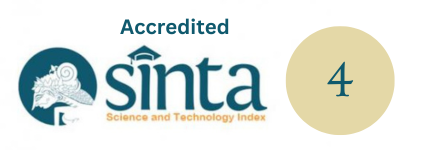Tabuh Lelambatan Klakat Sudhamala: A New Creative Musical Composition | Tabuh Lelambatan Klakat Sudhamala: Sebuah Komposisi Karawitan Kreasi Baru
DOI:
https://doi.org/10.59997/jurnalsenikarawitan.v1i1.191Keywords:
Tabuh lelambatan, Klakat Sudamala, Karawitan, new creationAbstract
The process of creating works of art, especially musical art, has begun to develop following the times. The development is in the process of creativity in the creation of musical art, it can be seen from the musical elements in musical art. In musical art it is very important in the process of creating a strong work of art for a renewal of tradition so that it can be said as creative music. The composer is interested to appoint the klakat sudamala which is woven bamboo as a braid of the composition of the drum percussion which is woven bamboo as an interwoven composition of the percussion of tabuh lelambatan collaborated in the gamelan Gong Kebyar as a medium of expression by using the two percussion pattern as the structure of the composition.The composer certainly has intends to achieve his goal, so that his work has a meaning to be used as the accompaniment of instruments (tabuh) when holding a yadnya ceremony in his village. The creative process of creating the composition tabuh dua "Klakat Sudamala" is inseparable from the process of creating works of art by Alma M Hawkins. Hopefully, the creation of the tabuh lelambatan contributes to the village in particular and to the Balinese musical world in general.
Downloads
References
A.A.M.Djelantik. 1999. Estetika: Sebuah Pengantar. Bandung: Masyarakat Seni Pertunjukan Indonesia (MSPI).
Aryasa, IWM W.M. Dkk. 1985. Pengetahuan Karawitan Bali. Denpasar: Departemen Pendidikan dan Kebudayaan Bali.
Garwa, I Ketut. 2009. Buku Ajar Komposisi Karawitan IV. Denpasar: Institut Seni Indonesia.
I Made Agus Bayu Antara, I Komang Sudirga, Hendra Santosa et al. 2018. Cak Ganjur: Sebuah Komposisi Musik Vokal Gabungan Cak Dan Balaganjur. Kalangwan : Jurnal Seni Pertunjukan, 4(2). https://jurnal.isi-dps.ac.id/index.php/kalangwan/article/view/495
Putu Paristha Prakasih, Hendra Santosa, I Gede Yudarta et al. 2018. “Tirtha Campuhan: Karya Komposisi Baru Dengan Media Gamelan Semar Pagulingan.” Resital: Jurnal Seni Pertunjukan 19(3): 113–21. http://journal.isi.ac.id/index.php/resital/article/view/2452.
Rembang, I Nyoman. 1985. Hasil Pendokumentasian Notasi Gending-Gending Lelambatan Klasik Pegongan Daerah Bali. Denpasar: Departemen Pendidikan dan Kebudayaan.
Santosa, Hendra., I Ketut Sudhana, Saptono. 2015. “Prototive Gamelan Sistem Sepuluh Nada Dalam Satu Gembyang.” Segara Widya 3(1): 482–88. http://jurnal.isi-dps.ac.id/index.php/segarawidya/article/view/219.
Santosa, Hendra; Saptono. 2016. “Gamelan Sistem Sepuluh Nada Dalam Satu Gembyang Untuk Olah Kreativitas Karawitan Bali.” Pantun 1(2): 85–96. https://jurnal.isbi.ac.id/index.php/pantun/article/view/747.
Santosa, Hendra. 2017. “Gamelan Perang Di Bali Abad Ke-10 Sampai Awal Abad Ke-21.” Sumedang: Universitas Padjadjaran.
Saptono, Tri Haryanto, and Dru Hendro. 2019. “Greng Sebuah Estetika Dalam Kerampakan Antara Gamelan Dan Vokal.” KALANGWAN Jurnal Seni Pertunjukan 5(1): 29–38.
Sugiartha, I Gede Arya. 2015. “Bentuk Dan Konsep Estetik Musik Tradisonal Bali.” Panggung 25(1): 46–60. https://jurnal.isbi.ac.id/index.php/panggung/article/view/14/18.
Yudarta, I Gede. 2002. “Tabuh Dua Lelambatan Pagongan, Analisa Struktur Dan Komposisi.” Bheri: Jurnal Ilmiah Musik Nusantara 1(1).








